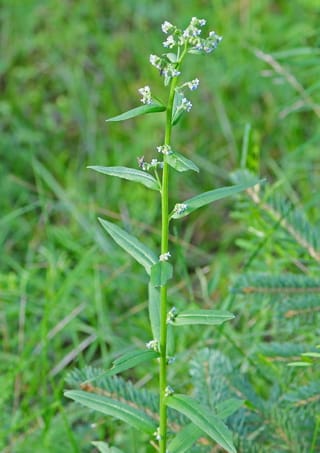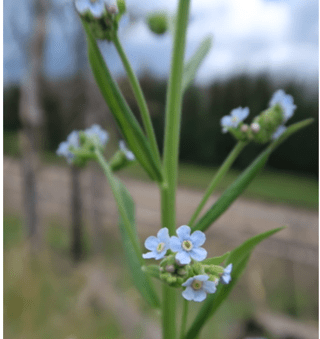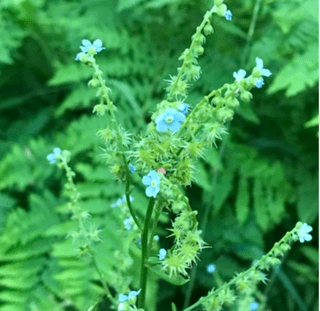This guide initially displays all weeds in the Los Alamos area classified in NM as noxious regardless of shape. Use the selectors below to include nonclassified weeds or select a specific set, either by shape or name.
The term weed is commonly used to denote a plant that is growing in an area where it is not valued. It is officially defined by the USDA Animal and Plant Health Inspection Service as being any plant that poses a threat to agriculture and/or a natural ecosystem. A noxious weed is one that is particularly troublesome and can directly or indirectly injure or cause damage to crops, livestock, or natural resources.
In general, plants that are within their native range live in balance with their environment and are not typically considered to be weeds. Issues can occur, however, if a plant is introduced, either directly or indirectly, to a new ecosystem. These, now non-native plants, may be able to thrive in their new environment. If so, these naturalized plants can fall into one or two categories long term: (1) plants that are valued for their flowers and fruit and (2) plants that are rapidly considered to be weeds. The plants in the latter category are those that are generally regarded as noxious weeds.
While some species shown here are included in the PEEC Flower and Tree Guides, this guide concentrates on some of the nastier introduced species that you might see in your yard or on local trails. In addition, this guide includes some native plants that meet the general definition of weed.
Weed References
A Plan For the Control of Invasive Species on Los Alamos County Open Space — Craig Martin [PDF]
Los Alamos Master Garden Weed List
NMSU Weed Information
SEINet: Southwest Biodiversity
Some Common Lawn and Garden Weeds of Los Alamos, NM — Dorothy Hoard and Teralene Foxx [PDF]
Troublesome Weeds of NM
USDA: Introduced, Invasive, and Noxious Plants
Weed Alert
Weeds of the Los Alamos Area — Teralene Foxx [PDF]
Subject Area Experts (all guides)
Steve Cary (butterflies)
Beth Cortright (insects)
Terry Foxx (invasive plants)
Leslie Hansen (mammals)
Richard Hansen (fish, mammals)
Dorothy Hoard (butterflies, trees)
Chick Keller (flowers, herbarium)
Shari Kelley (geology)
Kirt Kempter (geology)
Garth Tietjen (reptiles)
David Yeamans (birds)
Web Development and Content Management
Pat Bacha
Jennifer Macke
Graham Mark
Akkana Peck
Contact
Please contact us for local nature questions and sightings. We welcome comments, corrections, and additions to our guides.
For more information about local nature, please visit our Nature Blog or subscribe to PEEC This Week.
Make Selection
 Photo: Jerry Oldenettel  Photo: whitegategal  Photo: Robb Hannawacker |  Manyflower Stickseed, Many-Flower Stickseed, Manyflowered Stickseed, False Forget-Me-NotHAFL2 (Hackelia floribunda)Family: Boraginaceae (Borages) Size: 12 - 40 in (30 - 102 cm) Growth: forb/herb; biennial, perennial Status: native; nonclassified Native Range: most of North America NM Noxious Weed Class: not classified Habitat: meadows, wetlands, and riparian areas Control Notes: pull up plants, removing all of the root fragments; mow down second-year plants; spot-treat with herbicide Hackelia Floribunda is a nuisance plant. Its seeds are quite prickly contributing to the plant’s common name of Stickseed. The seeds tend to cling to pieces of clothing and potentially can cause some irritation. In areas where Manyflower Stickseed is prevalent, it is recommended that one stays on established roads and trails in order to unintentionally prevent picking up seeds. In addition, pets should be kept on a leash. Clothing, shoes, etc. should be cleaned off before moving to a new location. Manyflower Stickseed is a such plant with hairy stems that grow at a 45 degree angle. The leaves are smooth and lance-shaped. Individual pale blue flowers of no more than 0.25 in (6 mm) in diameter () form clusters at the ends of the stems. The fruits are small nutlets that are flattened and edged with a row of prickles. Various Native American peoples have used in a variety of ways from a good luck charm to the treatment of injury. In general, though, it was treated as a poison due to the skin irritation caused by the prickles. Info Photos Distribution Flower Guide |
